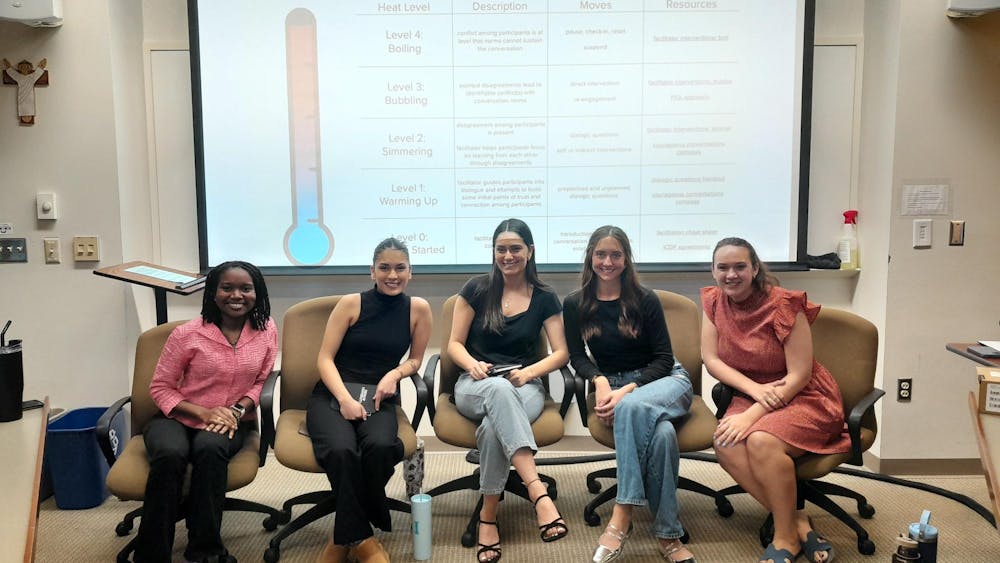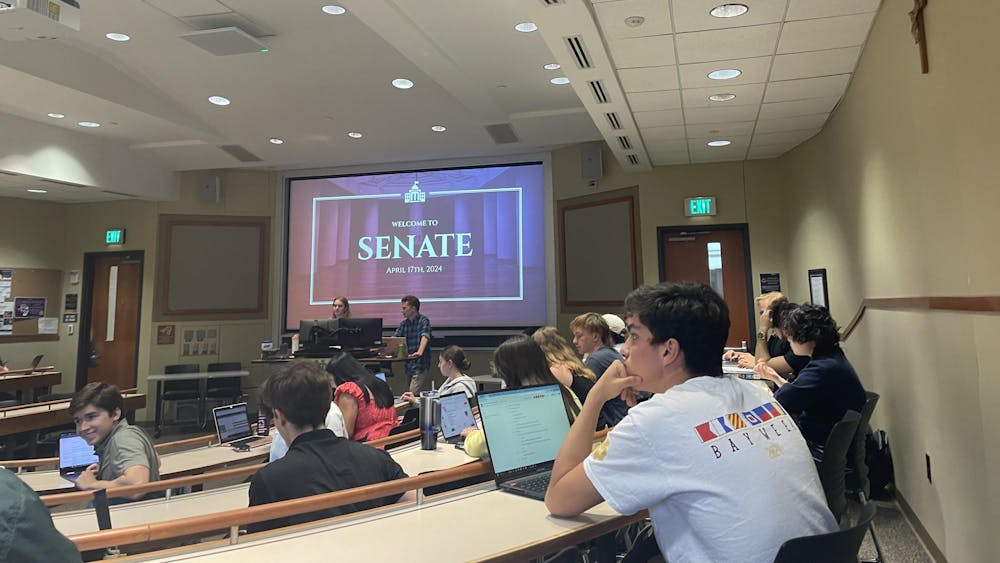Founded in 1990, The Shirt Project is the largest student-run fundraiser at the University of Notre Dame. The project's president and vice presidents estimate that it is also the number-one-selling single piece of collegiate apparel, selling over 150,000 units each year in the last few years.
Currently, the project is celebrating its 25th anniversary by auctioning off 24 of the 26 Shirts, signed by coaches and players who were at the University during each of those respective years. The auction will run until Dec. 10.
The Shirt Committee's current vice president Molly Howell, who will be replaced next semester when she goes abroad, described the circumstances surrounding the creation of The Shirt.
“It started in 1990, it was the idea of a student [Brennan Harvath] who ran An Tostal," Howell said. "He worked on it over the summer between his junior and senior year. It was his idea to use the shirt to raise funds for An Tostal.
“He had a design in mind, and then he worked with hall presidents and different people on campus — through letters really, over the summer — to sell the shirt and have it ready for the first game. So that sort of started the mission of the Shirt in the sense that its funds were meant to be used to support the student body and student activities."
President of The Shirt Committee junior Abbey Dankoff said Harvath also hoped to use the shirt as a way to unite the student body.
“He told us this recently ... that he was a member of the band so one of the major reasons that he wanted to start The Shirt was that they all had to wear uniforms in the band," Dankoff said. "He thought there should be a unifying front for the students as well. He really liked that idea, a unified student section."
Howell said the first Shirt sold out in its first weekend. After its initial success, another Shirt was created for the University’s Miami game later in the 1990 season, she said.
“Later in the season, a graduate student had been injured in a car accident and so they decided to create [the] second Shirt," Howell said. "This didn’t come from Harvath, but others on campus saw the success of the first shirt and decided that they would like to do another t-shirt sale to raise funds for the student because he was suffering from extraordinary medical costs. It did very well as well.
"That established the second part of the Shirt as it is today — part of the profits go to a certain fund that helps students that are suffering from extraordinary medical conditions and have these costs that they just can’t afford to pay.”
Dankoff said about 2 million Shirts have been sold in the last 25 years and around $8 million raised. Dankoff said that the committee does not have concrete numbers because good records were not kept during the first few years of The Shirt Project. Until several years ago there were only six members of The Shirt Committee, and presently there are ten, Dankoff said.
“So the Shirt has definitely grown and evolved in the last 25 years. And today, it’s a little different, it still has the basic mission to support and unite the student body, but the funds go a few different places now,” Howell said. “Once we have the profits from the shirt, which go directly to us, they are divided into two separate accounts. One is the Student Union, and one is the Shirt Charity Endowment.”
Half of the profit money goes to the Student Union, and it is then split into two parts; some goes to help to help fund the more than 400 clubs on campus, and to alleviate the student activity fee that, because of the money from The Shirt, has not gone up since 2010 according to Howell. The other money that goes to the Student Union goes into the Student Union endowment, which allows for The Shirt Project to grow, Howell said.
The other half goes towards charities funded by The Shirt Project, Howell said.
“It goes to two different things; one is the Rector Fund, which people might be familiar with," Howell said. "It’s the fund that students can apply to get funds from, for football tickets, for dance tickets, for senior photos; things that most Notre Dame students do and participate in but that do have a financial component. If they can’t afford it, they apply for the Rector Fund. It’s called the Rector Fund because you go through you rector to apply for it."
Dankoff said another important aspect of the rector fund is academic instead of social.
“We do currently also cover textbooks while supplies last, but traditionally the rector fund is completely used up before winter break, within the fall semester it is usually used up," Dankoff said. "We are actually working currently on a reallocation of the rector fund and a redistribution towards it that would allow more money to go there."
Howell said the second part of the money from The Shirt charities goes to helping students with large medical costs.
“The second portion of funds goes to The Shirt charity medical account," Howell said. "Students may also apply to that one if they are for whatever reason unfortunately suffering from extraordinary illness or an accident and they have these medical costs. That’s confidential, and we don’t deal directly with those individuals, it goes through the financial management board which is run by students."
With the proposed reallocation of funds, Howell said there would be $100,000 in the medical account at all times, while the remainder of the charity money would go to the Rector Fund, which is funded solely by The Shirt Project. Ideally, this would make more funds available to students.
“Our main message is that all the funds in different ways are returned back to the student body, or are available for the student body to use,” Howell said.
Dankoff and Howell both stressed that the purpose of The Shirt Project is to aid students at the University.
“Just by purchasing a shirt, students are really supporting themselves and supporting everybody else at this university," Dankoff said. "It really kind of adds to the inclusiveness of the mission of Notre Dame as a whole."













